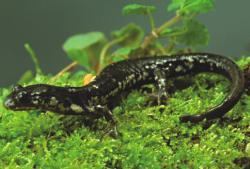Wehrle's salamander facts for kids
Quick facts for kids Wehrle's salamander |
|
|---|---|
 |
|
| Conservation status | |
| Scientific classification |
The Wehrle's salamander (Plethodon wehrlei) is a type of salamander. It belongs to a family called Plethodontidae, which means they breathe through their skin! This salamander only lives in the Eastern United States. It was named after Richard White Wehrle, who was a jeweler and a nature lover.
Contents
Where Wehrle's Salamanders Live
Wehrle's salamanders can be found from New York all the way south to Virginia. Scientists have studied these salamanders closely. They found that some groups of salamanders once thought to be Wehrle's salamanders are actually different species!
For example, salamanders in parts of Virginia and North Carolina are now known as the Blacksburg salamander. Also, a group living in a cave in Virginia is now called the Dixie Cavern salamander. Another group with yellow spots, found on the Cumberland Plateau, is now its own species, the yellow-spotted woodland salamander. This shows how scientists learn more about animals all the time!
What Wehrle's Salamanders Look Like
Wehrle's salamanders have a cool look! They are mostly bluish-black. They have large, scattered white spots on their back. Their sides are covered with white or yellow spots and blotches.
Their belly and the underside of their tail are a solid gray color. The throat and upper chest often have white or yellowish blotches. These salamanders can grow to be about 10 to 17 centimeters (4 to 7 inches) long.
Wehrle's Salamander Reproduction
Wehrle's salamanders usually mate from fall through spring. In early summer, the female lays a large group of eggs. She places these eggs in damp places like inside logs, in the soil, or in moss. They can also lay eggs in cracks inside caves.
Not all adult females breed every year. Their reproduction can be every two years or sometimes even less often.
How Wehrle's Salamanders Behave and Where They Live
During the day, Wehrle's salamanders like to stay hidden. They come out at night to look for food. You can find these salamanders on forested hillsides in the Appalachian Plateau. They hide under stones or rocks during the day.
They also like to live near the entrances of caves and in deep cracks in rocks. Sometimes, they will hide in burrows under rocks and logs.


